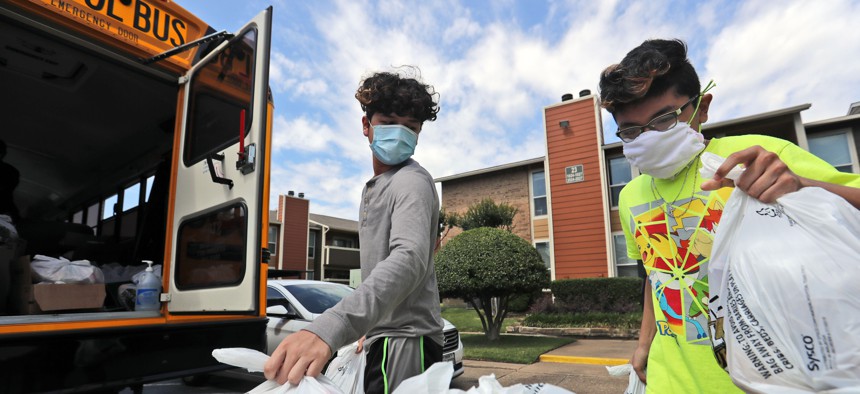USDA Extends Free School Meal Program for Children

Amid concerns of the spread of COVID-19, brothers Brian, left, and David Rayo wear masks as they pick up school lunches for themselves and other siblings at their apartment complex in Dallas, Tuesday, May 5, 2020. AP Photo/LM Otero
The U.S. Department of Agriculture loosened requirements for children receiving free meals through their schools at the start of the coronavirus pandemic and announced Monday it would keep those flexibilities in place through the end of the year.
Whether children return to school in person or online, they will all be eligible to receive free meals this fall, the U.S. Department of Agriculture announced Monday.
Eligibility requirements for the summer meals program were waived amid the coronavirus pandemic, allowing greater flexibility in the program and providing millions of school children access to free meals even if they didn’t meet the income requirements in place for the meals program during normal times. But the department had planned to reinstate some of the requirements in September, charging families for them if they didn’t meet financial need requirements and potentially making it more difficult for children and their parents to obtain free meals.
The USDA said Monday it will allow the flexibilities to continue through Dec. 31 as long as it has the funding to do so.
The department’s waivers will allow:
· Meals to be provided at no cost.
· Meals to be served outside the typically required group settings and at specific mealtimes.
· Parents or guardians to pick up meals for their children without requiring the children to be present.
The continued extension of the summer program will “ensure meals are reaching all children – whether they are learning in the classroom or virtually,” said Agriculture Secretary Sonny Perdue.
The USDA’s decision came after members of Congress, advocacy groups and school leaders from across the country warned that if the waivers expired, it would become difficult for needy families to access the school meals and children would go hungry.
Under the waivers, for example, parents could pick up multiple days’ worth of meals for all of their children at one school even if their children attended different schools. Without them, parents would have to travel to each child’s school to get their meals. The waivers also allowed all children to receive free meals, whether or not they were financially eligible for free and reduced-cost lunch. If the waivers had expired, families would have had to start paying for meals unless they qualified for the free meal program.
Before the pandemic, nearly 30 million children received free or reduced-cost lunches at school every day.
Advocacy groups and school personnel praised the USDA’s reversal on Monday.
Families that might not have previously qualified for free meals at school may still be facing financial difficulties due to the ongoing pandemic, and the continuation of the waivers ensures they have access to food, said Lindsay Aguilar, the director of food services for Tucson Unified School District in Arizona.
“Now their children will have one less thing to worry about as they adjust to evolving in-school and remote learning scenarios,” Aguilar said. “These waivers also eliminate a massive administrative burden for our school nutrition staff, allowing them to focus on feeding children.”
But advocacy groups said that, given the ongoing nature of the pandemic, the waivers should be extended through the end of the academic school year.
“This extension will ensure schools and private nonprofit organizations serving as summer meal program operators have the flexibility to reach low-income children who rely on free and reduced-price school meals while schools are shuttered or have schedules that include both remote and in-classroom learning,” said Luis Guardia, president of the Food Research and Action Center. “By extending all waivers throughout the school year, schools and program operators will have the ability to efficiently and easily provide meals to children.”
By extending the waivers for just a few months at a time, the USDA is creating unnecessary confusion about the program, said Lisa Davis, the vice president of Share Our Strength, the organization that runs No Kid Hungry.
“To feed millions of children, schools need time to thoughtfully plan and prepare,” Davis said. “Last minute, stop-gap measures like these can create confusion for parents and barriers to the long-term planning needed to reach the unprecedented number of kids going hungry in our country right now.”
But without action from Congress, the USDA does not have the authorized funding to continue the program through the rest of the school year, the department said in a statement.
“USDA has continuously recalculated remaining appropriated funds to determine how far we may be able to provide waivers into the future, as Congress did not authorize enough funding for the entire 2020-2021 school year,” the department said.
The USDA said it will continue to monitor funding available for the school meals program and to inform Congress of any future limitations.
Andrea Noble is a staff correspondent with Route Fifty.
NEXT STORY: California Bill Would Require Corporate Boards to Diversify





